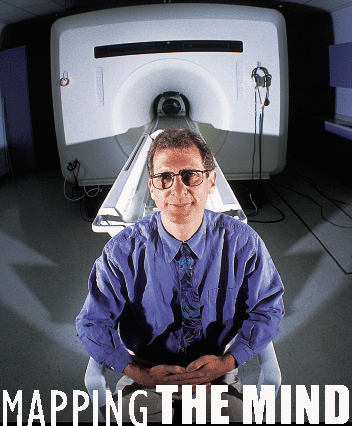

Perhaps it is not surprising that most of us live with an impression about the mechanistic nature of our brains that dates back to the 17th century and the thinking of French philosopher René Descartes. In this model, the brain presents the external world to the mind. It is in the mind, which exists as a separate organ, or even a separate substance, that consciousness takes place. This concept for which the philosopher Daniel Dennett has coined the term the "Cartesian theater" suggests, in effect, that somewhere in our brain is an object that holds the essence of our consciousness and that this runs the rest of our brain. "The Cartesian theater is flawed terribly," says UCLA neuroscientist Mark Cohen, "and yet it is the world model we tend to live in."
According to Cohen, the brain is organized in a much more democratic manner. There are unique functions for separate regions of our brains, and these all cooperate to create what we experience as consciousness.
But how can this be proved? Imagine a machine that could peer into your brain, with a millimeter spatial resolution and control, that could tell you what part was doing the work whenever you were thinking, dreaming, feeling pain, falling in love, imagining the future or anything else your brain might do. It was that kind of device Cohen was longing for when he received his doctoral degree in neuroscience in 1985. what he wanted out of his work, he says, was to understand the relationship between brain structure and function. Given the state of technology, he was convinced he didn't have a prayer. "It was my impression," he recalls, "that it was truly irrelevant how many electrodes you stuck into an animal, you would never have a clue how it felt." Disillusioned, he left neuroscience after receiving his doctorate.
So Cohen went into biomedical technology, and set to work trying to make an MRI scanner that could image the human body in less than the standard 40 minutes it took at the time. And with that seemingly orthogonal career choice, Cohen launched himself on a path that has brought him back 13 years later to attaining his original goal. Now an associate professor of neurology, radiology and psychiatry working within the UCLA Brain Mapping MRI laboratory, he works with the world's fastest MRI machine, exploring some of the most exciting questions in cognitive science. "Five years ago I came to UCLA with the goal of setting up a state-of-the-art magnetic resonance imaging lab dedicated to the observation of brain function, and with the tremendous support of the UCLA Brain mapping center, under Professor John Mazziotta, that's what we've done," Cohen says.
The MRI machine he designed is capable of imaging changes in blood-flow patterns in the human brain every 10 or 20 milliseconds, and can provide the images to researchers in real time. The resolution it can achieve is within a tenth of a second in time and a millimeter in space. It has allowed Cohen and his collaborators to set up what he calls "a psychology laboratory in a horizontal tube."
While lying inside the scanner, research subjects and patients watch visual stimuli on a computer screen, listen to auditory stimuli and respond to what they're seeing by performing assigned tasks. While that's happening, Cohen and his collaborators take a series of MRI images of the subject's brain, in some cases monitoring brain electrical activity (EEG) as well. "With this technique," he explains, "it is possible for people to perform most any cognitive task, while we observe their brains using noninvasive, passive listening techniques and watch and record areas of brain activity."
The MRI laboratory and scanner are used as a shared resource by many members of the UCLA research community, which means that the range of projects going on is enormous: from surgical planning÷in which, for instance, a surgeon may determine in advance what part of the brain might either be safely removed or avoided carefully÷to pure research projects. At present, Cohen and his collaborators are studying how the brain maps the positions of objects defined visually; how it maps and deals with color perception and the definition of objects; even how the brain is involved in the process of craving in nicotine addiction.
Cohen's personal favorite area of study is the relationship between perception and sensation, a field of study known as mental imagery. From a range of experiments, Cohen and his colleagues have learned that the brain responds with a similar mechanism and similar computing machinery to both internally and externally generated perceptions. "The very same part of your brain that might perceive the motion of an external object," he explains, "is involved in thinking about moving things. But this concept has a flip side, which is that because of the way our brain perceives things, it is very tough for us to imagine things that aren't physical, and that we cannot hear, touch, taste or see. If you don't have sensory organs for it, your brain hasn't developed the neural machinery for it, and your mind can't access it. While exploring the physiological basis of pure imagination, we are also developing an understanding of the profound limitations on human consciousness."
In fact, Cohen's list of projects his laboratory hopes to tackle seems to go on and on. Even he can't readily tick them all off: "The neuroanatomy of memory; what parts of the hippocampus are involved in what tasks; the laterality of brain functions, which is how cognitive tasks are split between left and right brain; the sensation of pain. Ahhhh, what else? The list is long and it's very, very hard to get to the end . . ."